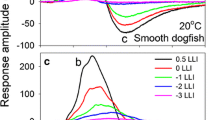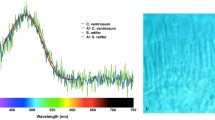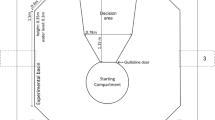Abstract
In most animals, vision plays an important role in detecting prey, predators and conspecifics. The effectiveness of vision in assessing cues such as motion and shape is influenced by the ability of the visual system to detect changes in contrast in both space and time. Understanding the role vision plays in shark behaviour has been limited by a lack of knowledge about their temporal resolution, contrast sensitivity and spatial resolution. In this study, an electrophysiological approach was used to compare these measures across five species of sharks: Chiloscyllium punctatum, Heterodontus portusjacksoni, Hemiscyllium ocellatum, Mustelus mustelus and Haploblepharus edwardsii. All shark species were highly sensitive to brightness contrast and were able to detect contrast differences as low as 1.6%. Temporal resolution of flickering stimuli ranged from 28 to 44 Hz. Species that inhabit brighter environments were found to have higher temporal resolution. Spatial resolving power was estimated in C. punctatum, H. portusjacksoni and H. ocellatum and ranged from 0.10 to 0.35 cycles per degree, which is relatively low compared to other vertebrates. These results suggest that sharks have retinal adaptations that enhance contrast sensitivity at the expense of temporal and spatial resolution, which is beneficial for vision in dimly lit and/or low contrast aquatic environments.








Similar content being viewed by others
Abbreviations
- ANOVA:
-
Analysis of variance
- CFFF:
-
Critical flicker fusion frequency
- cpd:
-
Cycles per degree
- ERG:
-
Electroretinogram
- FFT:
-
Fast Fourier transform
- FL:
-
Fork length
- LED:
-
Light-emitting diode
- MS222:
-
Methanesulfonate salt
- PERG:
-
Pattern electroretinogram
References
Anderson S, Henderson R, Pyle P, Ainley D, Klimley A (1996) White shark reactions to unbaited decoys. In: Klimley A, Ainley D (eds) Great white sharks: the biology of Carcharodon carcharias. Academic Press, San Diego, pp 223–228
Armington JC, Adolph AR (1990) Local pattern electroretinograms and ganglion cell activity in the turtle eye. Int J Neurosci 50:1–11
Bach M, Hawlina M, Holder GE, Marmor MF, Meigen T, Miyake Y (2000) Standard for pattern electroretinography. Doc Ophthalmol 101:11–18
Baker RA, Gawne TJ, Loop MS, Pullman S (2007) Visual acuity of the midland banded water snake estimated from evoked telencephalic potentials. J Comp Physiol A 193:865–870
Bartol S, Musick JA, Ochs AL (2002) Visual acuity thresholds of juvenile loggerhead sea turtles (Caretta caretta): an electrophysiological approach. J Comp Physiol A 187:953–960
Bates D, Maechler M, Bolker B, Walker S (2013) lme4: linear mixed-effects models using Eigen and S4. R package version 1. http://lme4.r-forge.r-project.org/
Bedore CN, McComb DM, Frank TM, Hueter RE, Kajiura SM (2013) Effects of temperature and anesthesia on visual temporal resolution in elasmobranch fishes. Oceanography Faculty Proceedings, Presentations, Speeches, Lectures Paper 142. http://nsuworks.nova.edu/occ_facpresentations/142
Bigelow HB, Schroeder WC (1948) Fishes of the Western North Atlantic: part 1 lancelets, cyclostomes, sharks. Memoir sears foundations for marine research. Yale University, New Haven
Bilotta J, Lynd FM, Powers MK (1998) Effects of mean luminance on goldfish temporal contrast sensitivity. Vis Res 38:55–59
Bonds A, Casagrande V, Norton T, DeBruyn E (1987) Visual resolution and sensitivity in a nocturnal primate (Galago) measured with visual evoked potentials. Vis Res 27:845–857
Brainard DH (1997) The psychophysics toolbox. Spat Vis 10:433–436
Campbell F, Green D (1965) Monocular versus binocular visual acuity. Nature 208:191–192
Campbell F, Maffei L (1970) Electrophysiological evidence for the existence of orientation and size detectors in the human visual system. J Physiol 207:635–652
Cao D, Zele AJ, Pokorny J (2007) Linking impulse response functions to reaction time: rod and cone reaction time data and a computational model. Vis Res 47:1060–1074
Chalupa LM, Werner JS (2004) The visual neurosciences. MIT Press, Cambridge
Compagno LJV (1990) Alternative life-history styles of cartilaginous fishes in time and space. Environ Biol Fishes 28:33–75
Conner J, MacLeod D (1977) Rod photoreceptors detect rapid flicker. Science 195:698–699
Crozier W, Wolf E (1939) The flicker response contour for the gecko (rod retina). J Gen Physiol 22:555–566
Crozier W, Wolf E (1941a) The flicker response contour for Phrynosoma (horned lizard; cone retina). J Gen Physiol 24:317–324
Crozier W, Wolf E (1941b) The simplex flicker threshold contour for the zebra finch. J Gen Physiol 24:625–633
Davis SP, Finarelli JA, Coates MI (2012) Acanthodes and shark-like conditions in the last common ancestor of modern gnathostomes. Nature 486:247–250
de Tejada PH, Tedó CM (1998) Contrast sensitivity function of the albino rat determined electrophysiologically. Span J Psychol 1:11–17
Dodt E, Wirth A (1954) Differentiation between rods and cones by flicker electroretinography in pigeon and guinea pig. Acta Physiol Scand 30:80–89
Dowling JE, Ripps H (1970) Visual adaptation in the retina of the skate. J Gen Physiol 56:491–520
Eckert M, Zeil J (2001) Toward an ecology of motion vision. In: Zanker J, Zeil J (eds) Motion vision: computational, neural, and ecological constraints. Springer, Berlin, pp 333–369
Enroth-Cugell C, Robson JG (1966) The contrast sensitivity of retinal ganglion cells of the cat. J Physiol 187:517–552
Fleishman LJ, Marshall CJ, Hertz PE (1995) Comparative study of temporal response properties of the visual system of three species of anoline lizards. Copeia 2:422–431
Froese R, Pauly D (2013) FishBase. http://www.fishbase.org
Fuss T, Bleckmann H, Schluessel V (2014) Place learning prior to and after telencephalon ablation in bamboo and coral cat sharks (Chiloscyllium griseum and Atelomycterus marmoratus). J Comp Physiol A 200:37–52
García-Pérez MA, Peli E (2001) Luminance artifacts of cathode-ray tube displays for vision research. Spat Vis 14:201–215
Ghim MM, Hodos W (2006) Spatial contrast sensitivity of birds. J Comp Physiol A 192:523–534
Gilbert PW (1970) Studies on the anatomy, physiology, and behavior of sharks. Final report office of naval research, Washington, D.C
Gramoni R, Ali MA (1970) L’électrorétinogramme et sa fréquence de fusion chez Amia calva (Linné). Can Biol 29:353–363
Granit R (1933) The components of the retinal action potential in mammals and their relation to the discharge in the optic nerve. J Physiol 77:207–239
Green DG, Siegel IM (1975) Double branched flicker fusion curves from the all-rod skate retina. Science 188:1120–1122
Gruber SH (1975) Duplex vision in the elasmobranchs: histological, electrophysiological and psychophysical evidence. In: Ali MA (ed) Vision in fishes: new approaches in research. Springer, Berlin, pp 525–540
Gruber SH, Cohen JL (1985) Visual system of the white shark, Carcharodon carcharias, with emphasis on retinal structure. Mem South Calif Acad Sci 9:61–72
Gruber SH, Myrberg AA (1977) Approaches to the study of the behavior of sharks. Am Zool 17:471–486
Hamasaki D, Peregrin J (1970) A blue-sensitive system in the lateral eye of the green iguana. Vis Res 10:121–127
Hammerschlag N, Martin RA, Fallows C, Collier RS, Lawrence R (2012) Investigatory behavior toward surface objects and nonconsumptive strikes on seabirds by white sharks, Carcharodon carcharias, at Seal Island, South Africa (1997–2010). In: Domeier ML (ed) Global perspectives on the biology and life history of the white shark. CRC Press, Boca Raton
Hanke FD, Scholtyssek C, Hanke W, Dehnhardt G (2011) Contrast sensitivity in a harbor seal (Phoca vitulina). J Comp Physiol A 197:203–210
Harahush BK, Hart NS, Green K, Collin SP (2009) Retinal neurogenesis and ontogenetic changes in the visual system of the brown banded bamboo shark, Chiloscyllium punctatum (Hemiscyllidae, Elasmobranchii). J Comp Neurol 513:83–97
Harris L (1978) Contrast sensitivity and acuity of a conscious cat measured by the occipital evoked potential. Vis Res 18:175–178
Hart NS, Theiss SM, Harahush BK, Collin SP (2011) Microspectrophotometric evidence for cone monochromacy in sharks. Naturwissenschaften 98:193–201
Heck J (1957) The flicker electroretinogram of the human eye. Acta Physiol Scand 39:158–166
Hemmi J, Mark R (1998) Visual acuity, contrast sensitivity and retinal magnification in a marsupial, the tammar wallaby (Macropus eugenii). J Comp Physiol A 183:379–387
Heupel M, Bennett M (1998) Observations on the diet and feeding habits of the epaulette shark, Hemiscyllium ocellatum (Bonnaterre), on Heron Island Reef, Great Barrier Reef, Australia. Mar Freshwater Res 49:753–756
Hodos W, Ghim MM, Potocki A, Fields JN, Storm T (2002) Contrast sensitivity in pigeons: a comparison of behavioral and pattern ERG methods. Doc Ophthalmol 104:107–118
Hueter RE (1990) Adaptations for spatial vision in sharks. J Exp Zool 256:130–141
Ikeda H, Wright M (1972) Receptive field organization of ‘sustained’ and ‘transient’ retinal ganglion cells which subserve different functional roles. J Physiol 227:769–800
Jamieson G, Fisher H (1971) The retina of the harbour seal, Phoca vitulina. Can J Zool 49:19–23
Jenssen TA, Swenson B (1974) An ecological correlate of critical flicker-fusion frequencies for some Anolis lizards. Vis Res 14:965–970
Kalinoski M, Hirons A, Horodysky A, Brill R (2014) Spectral sensitivity, luminous sensitivity, and temporal resolution of the visual systems in three sympatric temperate coastal shark species. J Comp Physiol A 200:997–1013
Kelly D (1972) Flicker. In: Jameson D, Hurvich LM (eds) Visual psychophysics (handbook of sensory physiology), vol 7/4. Springer, Berlin
Kirschfeld K (1976) The resolution of lens and compound eyes. In: Zettler F, Weiler R (eds) Neural principles in vision, vol Proceedings in Life Sciences. Springer, Berlin, pp 354–370
Klimley A, Pyle P, Anderson S (1996) Tail slap and breach: agonistic displays among white sharks. In: Klimley A, Ainley D (eds) Great white sharks: the biology of Carcharodon carcharias. Academic Press, London, pp 241–255
Kline RP, Ripps H, Dowling JE (1978) Generation of b-wave currents in the skate retina. Proc Natl Acad Sci 75:5727–5731
Kobayashi H (1962) A comparative study on electroretinogram in fish, with special reference to ecological aspects. J Shimonoseki Coll Fish 11:17–148
Kuchnow KP (1971) The elasmobranch pupillary response. Vis Res 11:1395–1406
Land MF, Nilsson D (2012) Animal eyes. Oxford University Press, New York
Land MF, Osorio DC (2003) Colour vision: colouring the dark. Curr Biol 13:R83–R85
Laughlin SB (2001) Energy as a constraint on the coding and processing of sensory information. Curr Opin Neurobiol 11:475–480
Lisney TJ, Collin SP (2008) Retinal ganglion cell distribution and spatial resolving power in elasmobranchs. Brain Behav Evol 72:59–77
Lisney TJ, Rubene D, Rózsa J, Løvlie H, Håstad O, Ödeen A (2011) Behavioural assessment of flicker fusion frequency in chicken Gallus gallus domesticus. Vis Res 51:1324–1332
Lisney TJ, Iwaniuk AN, Kolominsky J, Bandet MV, Corfield JR, Wylie DR (2012) Interspecific variation in eye shape and retinal topography in seven species of galliform bird (Aves: Galliformes: Phasianidae). J Comp Physiol A 198:717–731
Litherland L, Collin SP (2008) Comparative visual function in elasmobranchs: spatial arrangement and ecological correlates of photoreceptor and ganglion cell distributions. Vis Neurosci 25:549–561
Litherland L, Collin SP, Fritsches KA (2009) Visual optics and ecomorphology of the growing shark eye: a comparison between deep and shallow water species. J Exp Biol 212:3583–3594
Lythgoe JN (1980) Vision in fishes: ecological adaptations. In: Ali MA (ed) Environmental physiology of fishes, vol 35. NATO Advanced Study Institutes Series Springer, US, pp 431–445
Lythgoe JN (1988) Light and vision in the aquatic environment. In: Atema J, Fay RR, Popper AN, Tavolga WN (eds) Sensory biology of aquatic animals. Springer, New York, pp 57–82
Maffei L, Fiorentini A (1982) Electroretinographic responses to alternating gratings in the cat. Exp Brain Res 48:327–334
McComb DM, Frank TM, Hueter RE, Kajiura SM (2010) Temporal resolution and spectral sensitivity of the visual system of three coastal shark species from different light environments. Physiol Biochem Zool 83:299–307
McFarland W (1990) Light in the sea: the optical world of elasmobranchs. J Exp Zool 256:3–12
McFarland W, Loew E (1983) Wave produced changes in underwater light and their relations to vision. Environ Biol Fishes 8:173–184
Michael SW (2005) Reef sharks and rays of the world: a guide to their identification, ecology, and behaviour. ProStar Publications, Annapolis
Mustonen J, Rovamo J, Näsänen R (1993) The effects of grating area and spatial frequency on contrast sensitivity as a function of light level. Vis Res 33:2065–2072
Niven JE, Laughlin SB (2008) Energy limitation as a selective pressure on the evolution of sensory systems. J Exp Biol 211:1792–1804
Northmore D, Dvorak C (1979) Contrast sensitivity and acuity of the goldfish. Vis Res 19:255–261
Northmore D, Granda A (1991) Refractive state, contrast sensitivity, and resolution in the freshwater turtle, Pseudemys scripta elegans, determined by tectal visual-evoked potentials. Vis Neurosci 7:619–625
Northmore D, Oh D-J, Celenza M (2007) Acuity and contrast sensitivity of the bluegill sunfish and how they change during optic nerve regeneration. Vis Neurosci 24:319–331
Nowak LM, Green DG (1983) Flicker fusion characteristics of rod photoreceptors in the toad. Vis Res 23:845–849
Odom J, Bromberg N, Dawson W (1983) Canine visual acuity: retinal and cortical field potentials evoked by pattern stimulation. Am J Physiol Regul Integr Comp Physiol 245:R637–R641
Paulsson L, Sjostrand J (1980) Contrast sensitivity in the presence of glare light. Invest Ophthalmol Vis Sci 19:401–406
Peel L, Collin SP, Hart NS (2017) The visual system of the Port Jackson Shark: retinal structure, topography, and electrophysiology (unpublished)
Pelli DG (1997) The VideoToolbox software for visual psychophysics: transforming numbers into movies. Spat Vis 10:437–442
Perlman I (1995) The electroretinogram: ERG. In: Kolb H, Fernandez E, Nelson R (eds) Webvision: the organization of the retina and visual system. http://webvision.med.utah.edu
Porciatti V, Fontanesi G, Bagnoli P (1989) The electroretinogram of the little owl (Athene noctua). Vis Res 29:1693–1698
Pusch R, Kassing V, Riemer U, Wagner H-J, von der Emde G, Engelmann J (2013) A grouped retina provides high temporal resolution in the weakly electric fish Gnathonemus petersii. J Physiol 107:84–94
Rasengane TA, Allen D, Manny RE (1997) Development of temporal contrast sensitivity in human infants. Vis Res 37:1747–1754
Rinner O, Rick JM, Neuhauss SC (2005) Contrast sensitivity, spatial and temporal tuning of the larval zebrafish optokinetic response. Invest Ophthalmol Vis Sci 46:137–142
Ripps H, Dowling JE (1990) Structural features and adaptive properties of photoreceptors in the skate retina. J Exp Zool 256:46–54
Ryan LA, Meeuwig JJ, Hemmi JM, Collin SP, Hart NS (2015) It is not just size that matters: shark cruising speeds are species-specific. Mar Biol 162:1307–1318
Ryan LA, Hart NS, Collin SP, Hemmi JM (2016) Visual resolution and contrast sensitivity in two benthic sharks. J Exp Biol 219:3971–3980
Schieber NL, Collin SP, Hart NS (2012) Comparative retinal anatomy in four species of elasmobranch. J Morphol 273:423–440
Schluessel V, Rick I, Plischke K (2014) No rainbow for grey bamboo sharks: evidence for the absence of colour vision in sharks from behavioural discrimination experiments. J Comp Physiol A 200:939–947
Seamone S, Blaine T, Higham TE (2014) Sharks modulate their escape behavior in response to predator size, speed and approach orientation. Zoology 117:377–382
Silveira L, Heywood C, Cowey A (1987) Contrast sensitivity and visual acuity of the pigmented rat determined electrophysiologically. Vis Res 27:1719–1731
Smith EL, Witzel DA, Pitts DG (1976) The waveform and scotopic CFF of the sheep electroretinogram. Vis Res 16:1241–1245
Stell WK, Hárosi FI (1976) Cone structure and visual pigment content in the retina of the goldfish. Vis Res 16:647–N644
Stell W, Witkovsky P (1973) Retinal structure in the smooth dogfish, Mustelus canis: light microscopy of photoreceptor and horizontal cells. J Comp Neurol 148:33–45
Strong WR (1996) Shape discrimination and visual predatory tactics in white sharks. In: Klimley P, Ainley DG (eds) Great white sharks: the biology of Carcharodon carcharias. Academic Press, New York, pp 229–240
Tappeiner C, Gerber S, Enzmann V, Balmer J, Jazwinska A, Tschopp M (2012) Visual acuity and contrast sensitivity of adult zebrafish. Front Zool 9:10
Van Hateren J (1993) Spatial, temporal and spectral pre-processing for colour vision. Proc R Soc Lond B Biol Sci 251:61–68
van Wyk M, Taylor WR, Vaney DI (2006) Local edge detectors: a substrate for fine spatial vision at low temporal frequencies in rabbit retina. J Neurosci 26:13250–13263
Vaudo JJ, Heithaus MR (2011) Dietary niche overlap in a nearshore elasmobranch mesopredator community. Mar Ecol Prog Ser 425:247–260
Verma R, Pianta MJ (2009) The contribution of human cone photoreceptors to the photopic flicker electroretinogram. J Vis 9:9
Walls GL (1942) The vertebrate eye and its adaptive radiation. Hafner, New York
Warrington RE, Hart NS, Potter IC, Collin SP, Hemmi JM (2017) Retinal temporal resolution and contrast sensitivity in the parasitic lamprey Mordacia mordax and its non-parasitic derivative M. praecox. J Exp Biol:150383
Yano K, Stevens JD, Compagno LJV (2007) Distribution, reproduction and feeding of the Greenland shark Somniosus (Somniosus) microcephalus, with notes on two other sleeper sharks, Somniosus (Somniosus) pacificus and Somniosus (Somniosus) antarcticus. J Fish Biol 70:374–390. doi:10.1111/j.1095-8649.2007.01308.x
Zar JH (1999) Biostatistical analysis. Prentice-Hall, US
Acknowledgements
We would like to acknowledge the financial support of the Western Australian State Government (to NSH and SPC) and the Sea World Research and Rescue Foundation (to NSH and LAR). We thank the staff and volunteers of Oceans Campus in Mossel Bay, who assisted with this study, especially Dr. Enrico Gennari and Mr. Alan Jardine. We would also like to acknowledge Ms. Caroline Kerr, Mr. Carl Schmidt, Ms. Lucille Chapuis and Dr. Ryan Kempster for their assistance in the use and maintenance of animals used in this study. All experiments complied with the Animal Welfare Act (2002) and were approved by the Animal Ethics Committee of The University of Western Australia (Approval RA/3/100/1220) and the South African Department of Environmental Affairs: Biodiversity and Coastal Research, Oceans and Coasts Branch (Permit RES2015/96).
Author information
Authors and Affiliations
Corresponding author
Electronic supplementary material
Below is the link to the electronic supplementary material.
Rights and permissions
About this article
Cite this article
Ryan, L.A., Hemmi, J.M., Collin, S.P. et al. Electrophysiological measures of temporal resolution, contrast sensitivity and spatial resolving power in sharks. J Comp Physiol A 203, 197–210 (2017). https://doi.org/10.1007/s00359-017-1154-z
Received:
Revised:
Accepted:
Published:
Issue Date:
DOI: https://doi.org/10.1007/s00359-017-1154-z




